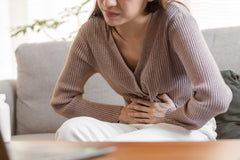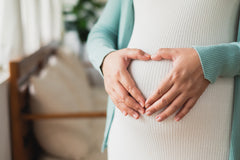Menstrual care can sometimes be an uncomfortable topic. But at Femallay, we aim to open the discussion to make everyone confident in their period care!
Today, we’re chatting about the question, “Are menstrual cups safe?” and how to have the best experience with menstrual cups!
Menstrual Cups, a U-shaped silicone cup that collects period discharge, has been gaining popularity in the crunchy or eco-friendly communities for years. We developed our own two products — Simplicity™ that follows the standard shape and Easy-Empty™ having a one-of-a-kind feature of being able to be emptied without being removed! Our two options fit various needs and can transform your period care system by providing a toxin-free, sustainable, and easy-to-use care option.

Are Menstrual Cups Safe?
Menstrual cups are incredibly safe to use, as long as you follow the proper cleaning protocol. If you’re concerned about infections related to cup use or tampon use, just know that those kinds of infections do occur, but are incredibly rare. Be sure to do your best to follow proper cleaning guides; for ease of access, here’s a brief rundown —
- Wash the cup thoroughly with a non-oil-based, unscented soap and water before use and once every 12 hours, preferably.
- Wash your hands before you insert or remove the cup every time. Having your nails trimmed is incredibly helpful to avoid germs and bacteria from entering your vagina.
- If you are simply removing the cup to empty it, you can rinse it with water or wipe it out with some toilet paper.
- Before you store the cup, wash it, sanitize it, and let it completely air dry before storing in the cotton bag. You may also wish to sanitize it before use at the start of every period cycle.
Note: Toxic Shock Syndrome (TSS) is always a possibility during your period, but with period cups, it seems to be a slightly less risk. Be sure to research TSS and know the signs so you can get medical care if you ever experience symptoms.
One other thing to be aware of is properly removing the cup. To avoid any prolapse, be sure to use your thumb and forefinger to grasp the cup, push in while pulling on the cup. You may need to bear down on the cup slightly, but try to keep that to a minimum. Kegel exercises will help to strengthen your pelvic floor muscles and keep everything in its proper place.
And that’s it! When you’re able to go up to 12 hours everyday without thinking about your period (while sleeping, swimming, exercising, etc.), those days of the month become more free than you’ve ever experienced with tampons!
How Menstrual Cups Help a Woman With Her Period
Women everywhere can enjoy using a menstrual cup, once she gets the hang of it! Here are some of the biggest benefits —
- Reduced Environmental Impact (Less Waste). Instead of using multiple plastic and cotton fibers that get thrown away each day of your period, one reusable period care item can last you for years!
- Fewer Cramps. Some people experience fewer cramps when using a period cup versus traditional disposable options.
- Comfortable Period. While tampons can cause vaginal dryness, cups don’t take away from your vaginal moisture or mess with your pH balance.
- Less Mess. After going through the learning curve and when inserted properly, the cup should not have leaks! You can wear them comfortably while working out, swimming, or showering.
- More Cost Efficient. A menstrual cup may cost between $25 to $45, however, it lasts up to ten years! Using a period cup can ultimately save you money, compared with the routine purchase of disposable tampons or pads.
What are the Disadvantages of Menstrual Cups?
With anything that’s new, there’s a learning curve! Here are some of the occasional barriers women face when they start using a menstrual cup.
- Messy to start. While you’re finding the right fold and learning how to take the cup out, you may experience a more messy period and have to get used to dealing with your own period discharge. Be sure to carry cleansing wipes for emergencies or a peri bottle to make cleaning your cup easier!
- Getting the folds down. There are a variety of folds that can work for you and your specific vaginal shape and cervix placement. Experimenting with different folds can greatly increase the ease of use.
- Finding the right fit. Our cups come in a small and large size; while you can answer a few questions to find the proper fit, you may find that you don’t fit traditional mechanisms and may need to try the other size for a better experience.
- Diagnosing why it’s leaking. A leaking cup can be such a hassle — but more often than not, it’s due to a heavy flow (and needing to empty it more often) or to an improper placement. After some practice, you should be able to go leak-free!
Is a Menstrual Cup Safer or Better Than Pads?
A menstrual cup can hold more fluid than a pad or tampon. This is extremely helpful for those who have a heavier flow or don’t have as much time in the day to change out period care. We always recommend using a reusable option whether you are using a menstrual cup, pad, underwear, disc, or a sea sponge.
Our cloth pads use antibacterial charcoal and bamboo to give you a softer, more absorbent experience. We think that cups give you more freedom, but reusable pads are a similarly safe and wonderful option.
Are Menstrual Cups Better Than Tampons?
Reusable options are always better for your health in that, unlike the cotton pads and tampons, they do not have toxic chemicals and by-products lingering. These chemicals have been linked with various fertility issues and illnesses that can be avoided, simply by not using them.
Ultimately, once you’ve done your research, looked at the pros and cons of various reusable period care items, and understand what would cause TSS — you can answer the question, Are menstrual cups safe for you?
If you have any other questions about menstrual cups and any issues you’re facing with your new period care routine, don’t hesitate to reach out to our helpful team at hello@femallay.com to get the answers you need!







